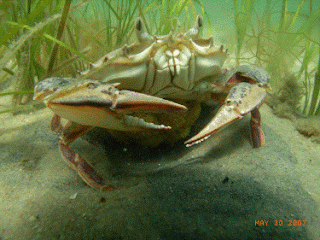 |
| HIMB beach scene - underwater. Photo M Heckman |
 |
| A single seagrass blade. M Heckman photo |
 |
| Seagrass flower. Photo from UH Botany site |
 |
| Image from National Marine Fisheries Service SWR |
 |
| Image from National Marine Fisheries Service SWR |
In Hawaii, the seagrasses in our shallow waters are quite elegant. They are the Halophilas, the salt lovers (from the Greek hals for salt and philos for love). We have two species, Halophila hawaiiana (endemic) and Halophila decipiens (worldwide distribution). Rather than having long flat blades, they have small canoe paddle-like blades - only an inch or so long. Most folks pass them right by, although our sea turtles do not (free greens for browsing)!
 |
| HIMB beach scene - the meadow - depth 1 foot. Photo M Heckman |
We will have more on this later, with some entries from Castle H.S. intern Rebecca Weible, who has been studying one of the patches off of the beach - and finding some surprising results.
In the mean time - check out the following sites or references for more information (and as sources for this articles).
 |
| Note the micro algae growing on the seagrass! Photo M Heckman |
Most enthusiastic sea grass website: Singapore's Team Seagrass.
"Cyrene Reef." Team SeaGrass.National Biodiversity Center, 11 Mar. 2012. Web. 17 March 2012.
For ID and other accurate info locally: University of Hawaii Botany Department, Marine Algae of Hawaii, http://www.hawaii.edu/reefalgae/invasive_algae/seagrasses/seagrasses.htm
 |
| Is that a flower on our seagrass? Photo M Heckman |
See also:
Seagrass Watch International.
Choi, Charles. "Behemoth Seagrass Clones Among Earth's Oldest Organisms." LiveScience, 1 Feb. 2012. Web. 17 March 2012. <http://www.livescience.com/18253-ancient-seagrass-clones-oldest-life.html>.
Fourqurean, J. "Sea Grass Monitoring Project." Florida Keys National Marine Sanctuary. NOAA, Aug 2011. Web. 16 March 2012.
http://floridakeys.noaa.gov/scisummaries/seagrass_monitor.pdf
"Importance." South Florida Aquatic Environments,Seagrasses.Ichthyology at the Florida Museum of Natural History. Web. 16 March 2012.
http://www.flmnh.ufl.edu/fish/southflorida/seagrass/importance.html
Coles, R. "Seagrasses in Queensland Waters." CRC Reef Research Centre, 2004 Web. 16 March 2012.
http://www.reef.crc.org.au/publications/brochures/CRC_Reef_seagrass_web.pdf
"Seagrass- Socioeconomic Importance."Habitat Conservation Division. NOAA's National Marine Fisheries Service, Southwest Regional Office, 03 Aug. 2011. Web. 16 March 2012.
http://swr.nmfs.noaa.gov/hcd/hcd_webcontent/socal/HAPC/seagrass3.htm
Greek definitions from: http://dictionary.reference.com/browse/philo- and
http://dictionary.reference.com/browse/halo

No comments:
Post a Comment